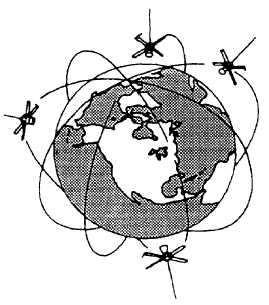Figure 1-6.—Satellite orbits.
run out. Each two-minute long satellite message is
timed so that the end of the 78th bit, which is the last
bit of the second synchronization signal, coincides
with even 2 minutes of Greenwich mean time (GMT).
Thus the satellites can also be used as an accurate
time reference by all navigators equipped with a
satellite navigation set.
Each satellite is designed to receive, sort, and
store data transmitted from the ground and to
retransmit this data at scheduled intervals as it circles
the earth. Each satellite tells users which satellite it
is, the time according to the satellite clock, and its
present location.
With this information, the user’s
navigation set can determine exactly where the
satellite is, one of the necessary steps toward
determining a precise navigational position.
Tracking Stations
Tracking
stations are located in Maine,
Minnesota, California, and Hawaii. As each satellite
passes within radio line-of-sight (los) of each of these
tracking stations, it is tracked to accurately determine
its present and future orbits. Just before predicted
satellite acquisition, the tracking station’s antenna is
pointed toward the satellite to acquire its signals. As
the satellite rises above the horizon, the tracking
antenna continues to follow the satellite’s predicted
path until the radio receiver in the tracking station
locks on to the satellite’s transmitted signal. The
receiver processor and data processing equipment
decode and record the satellite message. The Doppler
tracking signal is digitized and sent with the satellite
time measurements to the computing center, via a
control center, where a refined orbit is calculated.
The tracking stations maintain highly stable oscil-
lators that are continually compared against a WWV
transmitted frequency standard.
In addition, the
Naval Observatory sends daily messages that give the
error in the transmitted standard.
The Naval
observatory error is then added to the data obtained
from the frequency standard, and corrections are
made to the station oscillators. The station oscillators
are used to drive station clocks, which are compared
with the time marks received from the satellite. This
time data is transmitted by the tracking stations to the
control center, where the satellite clock error is
calculated and the necessary time correction bits are
added or deleted in the next injection message to the
satellite.
Computing Center
The central computing center continually accepts
satellite data inputs from the tracking stations and the
Naval Observatory.
Periodically, to obtain fixed
orbital parameters
for a satellite, the central
computing center computes an orbit for each satellite
that best fits the Doppler curves obtained from all
tracking stations. Using this computed orbital shape,
the central computing center extrapolates the position
of the satellite at each even 2-minutes in universal
time for the 12 to 16 hours subsequent to data
injection. These various data inputs are supplied to
the injection stations via the control center, as is data
on the nominal space of the orbits of the other
satellites, commands and time correction data for the
satellite, and antenna pointing orders for the injection
station antennas.
Injection Station
The injection stations, after receiving and
verifying the incoming message from the control
center, store the message until it is needed for
1-7


